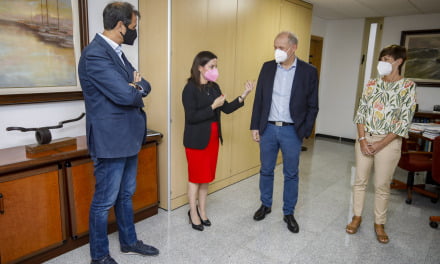The Island Commission for Cultural Heritage, part of the Cabildo de Gran Canaria, last Thursday May 5, reported favourably on the plan to construct a tunnel through the Cañada de Los Gatos, an area of significant archaeological importance, finally allowing the project to move forward, with the support of Mogán Town Hall and the tourist industry, to return the link between Taurito and Playa de Mogán along the original southern highway, the GC-500, avoiding the cliffs which even before the collapse in 2017 had been a point of serious concern due to their instability and the constant danger of landslides.
Mogán’s still incumbent mayoress, O Bueno, has grandly announced that she now plans to address the President of the Canary Islands Government, Ángel Víctor Torres, in her words, to ensure he “fulfils his commitment” to build the tunnel using Regional Autonomous Community funds, presumably rather than municipal or State funds, on the basis that this work has not been included in the road construction or maintenance agreements with the State. The construction cost of this 260+ meter tunnel has been calculated at about €12 million.
That stretch of road has been closed to vehicles since July 2017, when the first of two rockfalls occurred, along a section of about 650 meters. Although an attempt was made to reopen it to traffic with some emergency works, a new landslide in September of that same year meant the indefinite closure of the GC-500, for motor traffic, cyclists and pedestrians, where walls and barriers were erected across the carriageway to prevent access.
The Island government reported yesterday that the Historical Heritage Commission last Thursday, chaired by the insular advisor to the Presidency, Teodoro Sosa, “gave the go-ahead with conditions for this project, which will be carried out at kilometre point 44.7 on the GC-500, the route of which affects the Archaeological Zone of Cañada de Los Gatos, which has been declared a Site of Cultural Interest (BIC), due to its scientific importance within the chrono-cultural framework of historical indigenous populations of the Island and its state of conservation.
 The project plan from the Government of the Canary Islands will therefore include “measures that guarantee the conservation and protection of the BIC ensuring that none of the archaeological remains that make up [the site] will have their integrity compromised, neither during the course of the work nor during subsequent use of the new road infrastructure.”
The project plan from the Government of the Canary Islands will therefore include “measures that guarantee the conservation and protection of the BIC ensuring that none of the archaeological remains that make up [the site] will have their integrity compromised, neither during the course of the work nor during subsequent use of the new road infrastructure.”
To minimise “the significant visual impact” that the exit of the tunnel will likely cause above the archaeological zone, environmental recovery actions must also be carried out. Specifically, on the 650 meters of road that border the Cañada de Los Gatos, which will not be open for public use, the asphalt will be removed and, as much as possible, the original topography of the enclave will be recovered, guard rails, barriers and signage will be removed, and native vegetation encouraged to return.
The rest of the road not closed will be modified so that the the existing guard rails will blend in better with the surroundings or will be replaced by others more integrated into the landscape, and the same stone from the surroundings will be used in the construction of the tunnel’s mouth. Lastly, those responsible for the project must also remove the large build up of rubble that was dumped there when the GC-500 national road was built, which was deposited inside the BIC zone. All these actions will be overseen with archaeological controls and include archaeological excavations, consolidation and restoration works will also be carried out on some of the structures present within the BIC demarcated area.
READ ALSO
MOGAN RESIDENTS COLLECT SIGNATURES DEMANDING A SOLUTION TO THE CLOSURE OF THE GC500
Mogán tunnel project to re-establish links with Taurito and Playa de Mogán
A wall is suddenly built to prevent usage along road closed 18 months ago.
Mogán is broke
Keen observers over Mogán’s municipal finances might well have noticed that funding such a project would be simply impossible from town hall coffers anyway, regardless of whether or not the Regional Government had already agreed to foot the bill.
The local town hall administration, led by O Bueno’s CIUCA party’s much questioned absolute majority, has found itself on the verge of bankruptcy, according to reports and critics, due to serious “financial mismanagement” as well as a series of ill advised administrative and legal decisions that have left this town hall’s once brimming coffers somewhat lacking.
Having started the year 2021 with more than €20 million available to it, it is thought this town council had depleted that to around just €300,000 by October of last year, say their opposition, and have had to request millions of euros worth of loans just to stay operational with its current liabilities, something that voters will surely remember at the ballot boxes next year. A number of longstanding urban projects also remain unfinished, despite outside assistance, and so it will likely be the next administration that will have to pick up the bill for their final completion, late and overbudget.
The financing of the current administration’s various actions, it is thought, will take many years more of tax payers’ money to address. Though Bueno defends the dire financial situation by claiming it was down extra spending due to the pandemic, the fact is no other town council in the Canary Islands has claimed such a change of fortunes in the time of Covid. A series of legal misadventures, including ill advised appeals against already existing court judgements, various fines and compensations ordered against the town hall, have apparently cleared out the municipal accounts, which now, according to many observers, hang by a tenuous thread.
Of course, O Bueno will be speaking to the regional president, cap in hand, what else could they do?! The only way this long overdue tunnel gets built, and the road reopened, is with the support of the Regional Government, unless other state funds were to become available. Mogán is, it seems, broke, although it is not thought that, in itself, is what has held things up for this long. The fact is, this tunnel was put forward by the Cabildo de Gran Canaria, and it will be funded by the Canary Islands people. Any suggestion whatsoever that Bueno has any real influence over that is fanciful at best, but more likely simple political point scoring, in an attempt to take credit for what other larger institutions have already taken responsibility. As the 2023 local election season gears up, we can expect plenty more of this posturing, claiming kudos or credit for the ongoing work of more serious actors and institutions.
The good news is that there is finally some light at the end of the tunnel.














